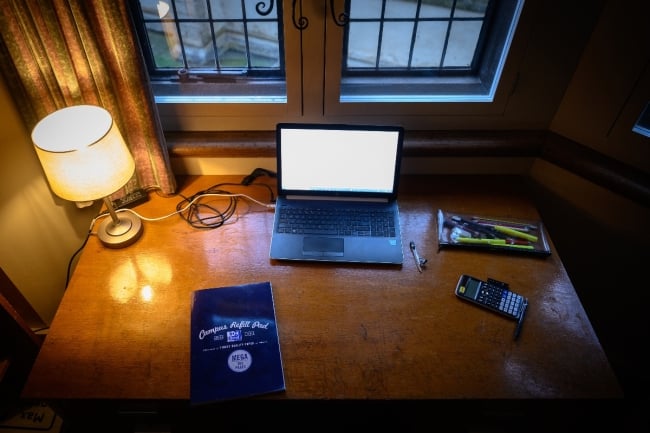You have /5 articles left.
Sign up for a free account or log in.

Two-thirds of first-year students struggled with online learning last year, according to a report released yesterday by ACT.
Leon Neal/Getty Images
When the COVID-19 pandemic prompted a sudden shift to online learning in the middle of the 2019-20 school year, a majority of first-year college students faced academic challenges, and many had trouble accessing proper resources, a new report finds.
Two-thirds of first-year students struggled with online learning last year, according to a report released yesterday by ACT, the nonprofit organization that administers the college readiness exam. Additionally, one-third of first-year students reported frequent troubles with an unreliable computer and 21 percent said they had unpredictable or no access to the internet.
The learning experience during a student's first year is a "critical predictor of student persistence," the report states. The move by more than 1,300 U.S. institutions to teach online in spring 2020 caused more disruption than usual for students.
“The first year of college is often a stressful time for college students, as the transition from high school to college brings new circumstances and expectations,” said ACT CEO Janet Godwin in a statement. “The past academic year was perhaps the most challenging year in the lives of American college students, particularly students from low-income families and first-generation college students, who were more likely to have limited access to technology and the internet compared to their counterparts.”
The report measured the responses from 1,164 students who took the ACT as a junior or senior between 2017 and 2019, graduated from high school in 2019, and enrolled in a postsecondary institution for the 2019-20 school year.
When students were asked to rate how easy or challenging their coursework was, 52 percent responded “somewhat challenging” and 14 percent responded “very challenging.” In an open-ended question, students cited lack of motivation, difficulty retaining information and trouble understanding concepts without “hands-on” experience as their biggest hurdles.
Furthermore, the report found that 82 percent of students were “a great deal” or “somewhat” concerned that online learning during the pandemic would negatively impact their academic success this year; 76 percent believed that such a negative effect could have long-term consequences.
The report named three key factors that created learning challenges for students: lack of access to technology and the internet, a gap in learning resources (such as instructor feedback, structured course materials and opportunities for collaboration), and limited prior experience with online learning.
Access to the internet varied among first-year college students, with more than half describing their internet connection as “OK,” 24 percent saying they had “great” connectivity and 21 percent calling it “unpredictable,” “terrible” or nonexistent.
The report comes as the House of Representatives yesterday passed a $3.5 trillion budget blueprint, paving the way for a vote on President Joe Biden's Infrastructure Investment and Jobs Act. The bipartisan infrastructure bill would create the Affordable Connectivity Program, an extension of the temporary Emergency Broadband Benefit passed by Congress last December to provide discounted broadband service to eligible low-income households, including Pell Grant recipients.
Emily Bouck West, deputy executive director for Higher Learning Advocates, which has been lobbying for broadband affordability programs for students, was pleased that the report details students’ struggles with broadband access.
“It's great that we have more data about the challenges that so many students are experiencing when trying to access and complete their coursework online,” Bouck West said. “Broadband connectivity challenges existed certainly before the pandemic but were absolutely exacerbated by the COVID-19 pandemic, and we’ve had very little data about how students are affected.”
Access to broadband and technology is part of a digital divide that “remains a persistent barrier,” the report states. Students from low-income families and first-generation college students were more likely to have limited access to technology and the internet compared to their peers, according to the report, with 49 percent of first-generation college students and 46 percent of students from low-income families reporting limited access to technology.
Thirty-five percent of students from low-income families and 30 percent of first-generation college students had limited access to the internet. Additionally, 25 percent of students from low-income families and 18 percent of first-generation students had limited access to both technology and the internet, whereas only 11 percent of their counterparts who didn’t identify as first generation or low income had issues with both.
“As online learning continues, universities and colleges should develop policies and plans to support students who lack access to technology and the internet, especially students from underserved populations,” reads one of the report’s recommendations.
Bouck West said the results of the report aren’t surprising and reflect why certain policy solutions, like the bipartisan infrastructure plan, are written to target issues that low-income students disproportionately face. She added that there’s “room for discussion” on how colleges could use other legislation to support students.
The Supporting Connectivity for Higher Education Students in Need Act, introduced in May 2020 by Senator Amy Klobuchar and Representative Anna Eshoo, would create a $1 billion fund to provide grants to colleges and universities to directly help their students pay for at-home internet connections as well as equipment such as laptops, routers and Wi-Fi modems.
“That would give colleges access to funding to identify students who might be struggling, that maybe aren’t Pell students, or maybe don’t have access to federal financial aid,” Bouck West said. “And so that’s certainly another worthy avenue to think about enabling institutions and providing specific funding for them to help address these challenges as well.”




